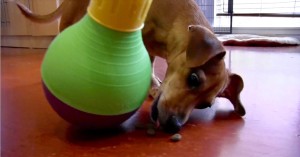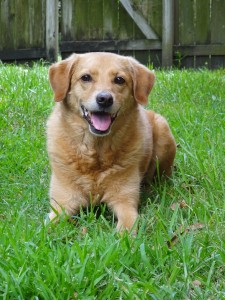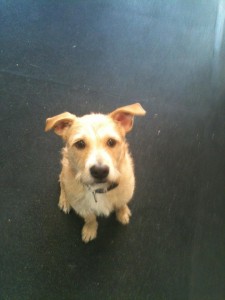Michael Baugh KPA-CTP CDBC CPDT-KSA
Feeding our dogs from enrichment toys, toys that dispense food, can actually make them smarter. It definitely seems to make them happy. Puzzling out the food inspires activity and thought. A lot of trainers liken it to the skills a scavenging dog or a hunting dog would need in order to eat the food they’d found or killed. Other trainers, me included, have noticed that it helps our dogs focus, activating their brains in a way boring bowl feeding simply doesn’t.
 It turns out we’re probably right. Animals (and human animals) who successfully learn challenging skills are more likely to be successful at subsequent challenging skills. In other words, succeeding at hard stuff makes us better at doing more hard stuff.
It turns out we’re probably right. Animals (and human animals) who successfully learn challenging skills are more likely to be successful at subsequent challenging skills. In other words, succeeding at hard stuff makes us better at doing more hard stuff.
The research actually dates back to the late 1970s. I came across it in Angela Duckworth’s great book, Grit: The Power of Passion and Perseverance. She cites the research of Dr. Robert Eisenberger from the University of Houston. He showed that rats that mastered a complicated task to earn food pellets, pressing a lever multiple times, we able to master subsequent complicated tasks (like running a maze) more easily. In fact they learned new tasks with more vigor and endurance. He ran related studies with children and college students in the 1980s with similar results. Eisenberger called the process Learned Industriousness.
Are our dogs learning to be more industrious because we feed them from food-dispensing toys? I think so. The task-based eating process is similar to what Eisenberger used, teaching the animal to work for the food. It also aligns with what many clicker trainers have observed. Dogs who learn tasks seem to learn how to learn. As they come to understand the process, the learning seems to come faster.
Almost all of my clients report that Mat Work, teaching their dog to lie on a mat, helps the dog become more focused. Mat Work is fairly complicated because it challenges the dog to figure out what do do with the mat (lie down on it) on his own. We don’t provide instructions, only feedback via clicks and treats. It’s a puzzle for the dog to solve. When we set it up properly and provide honest and clear reinforcement the dog figures it out, usually pretty quickly. It’s a hard skill that sets our dog up for more learning – for mastering other hard skills. In the clear light of Eisenberger’s research, all this seems to make more sense now. For a great primer on how Mat Work works, read Fired Up Frantic and Freaked Out by Laura Van Arendonk Baugh (no relation).
How do we teach our dogs learned industriousness? Let’s start with the toys. There are lots of great food-dispensing toys on the market. For beginners I recommend the Bob-A-Lot (pictured above). It’s perfect for feeding dry food. I’m also a big fan of the KONG Classic, which truly is a classic. Both are available online and at local retailers.
Michael Baugh KPA-CTP CDBC CPDT-KSA teaches dog training in Houston, TX. He specializes in helping dogs with aggression and fearful behavior


